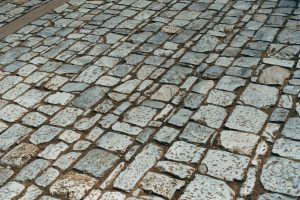Roads have been important to civilization for thousands of years. From ancient trade routes to modern highways, they have been a key part of how economies and societies have grown and changed. Roads have been built with many different kinds of materials over the years, and each has its own pros and cons.
Cobblestone has been around for a long time and has held up well. The Romans used cobblestone roads a lot, and you can still see them in many parts of Europe today. Small, oddly shaped stones were put on a base of packed sand and gravel to make these roads. They were long-lasting, easy to keep up, and gave both horses and people good traction.
But most roads today are made of black tar. On top of a base of packed soil and gravel, asphalt is put down to make these roads. Even though they are cheap and easy to build, they don’t last as long as cobblestone roads and need to be fixed up often to stay in good shape.
So, why are modern roads not as good as Roman roads made of cobblestones? This is caused by a number of things, which we will talk about in more detail below.
One of the main reasons why cobblestone roads were so long-lasting was that they were made from local, natural materials. Most of the stones used to build the roads came from nearby quarries, and they didn’t break down in the same way that modern materials like asphalt do.
On the other hand, black tar roads are made from things that come from oil and break down over time. When water and sunlight hit the asphalt, the oil and chemicals used to make it can break down. This can cause cracks and holes in the road surface. This can add up to a lot of money spent on repairs over time, and it can also put drivers and pedestrians in danger.
The way cobblestone roads were put together is another thing that makes them last longer. Roman engineers were very good at building roads, and they used many different methods to make sure that their streets would last.
For example, they would first put down a layer of sand and gravel to make the road’s base stable. Then, they would place the stones in a carefully planned pattern, using stones of different sizes and shapes to make a flat surface. Lastly, they would use smaller stones and sand to fill in the spaces between the larger stones, making a smooth, stable surface.
Modern techniques for building roads, on the other hand, tend to focus more on speed and cost-effectiveness than on durability. Engineers do take steps to make sure the road base is stable, but the process is often rushed and shortcuts may be taken to save time and money. This can make the road surface less stable and more likely to get cracks and holes over time.
Lastly, maintenance is a key part of how long a road surface will last. Cobblestone roads were easy to keep up with because each stone could be taken out and put back in place as needed. This meant that the road surface could stay in good shape for a long time without having to be fixed in big ways.
On the other hand, black tar roads must be fixed more often to keep them in good shape. To keep the road surface smooth and free of potholes, it must be regularly sealed and patched. If the road surface gets severely damaged, it may need major repairs. This can be expensive and take a lot of time, and it can also cause big problems with the flow of traffic.
In conclusion, the modern black tar roads aren’t as durable or long-lasting as ancient cobblestone roads, even though they have some advantages over them. The materials used to make them break down chemically over time, so they need to be maintained more often to stay in good shape.

